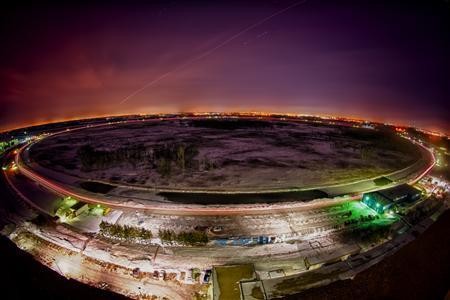
Scientists at the CERN research centre near Geneva, Switzerland, unveiled their latest findings on Wednesday in their search for the Higgs boson, a subatomic particle believed to be key to the formation of stars, planets and eventually life after the Big Bang 13.7 billion years ago.
The ATLAS and CMS experiments presented their latest preliminary results in the search for the long sought Higgs particle -often called the "God particle". They presented the findings at the year's major particle physics conference, ICHEP2012 in Melbourne. Both experiments observe a new particle in the mass region around 125-126 GeV.
"We observe in our data clear signs of a new particle, at the level of 5 sigma, in the mass region around 126 GeV. The outstanding performance of the LHC and ATLAS and the huge efforts of many people have brought us to this exciting stage," said ATLAS experiment spokesperson Fabiola Gianotti, "but a little more time is needed to prepare these results for publication."
"The results are preliminary but the 5 sigma signal at around 125 GeV we're seeing is dramatic. This is indeed a new particle. We know it must be a boson and it's the heaviest boson ever found," said CMS experiment spokesperson Joe Incandela. "The implications are very significant and it is precisely for this reason that we must be extremely diligent in all of our studies and cross-checks."
"It's hard not to get excited by these results," said CERN Research Director Sergio Bertolucci. " We stated last year that in 2012 we would either find a new Higgs-like particle or exclude the existence of the Standard Model Higgs. With all the necessary caution, it looks to me that we are at a branching point: the observation of this new particle indicates the path for the future towards a more detailed understanding of what we're seeing in the data."
The results presented today are labelled preliminary. They are based on data collected in 2011 and 2012, with the 2012 data still under analysis. Publication of the analyses shown today is expected around the end of July. A more complete picture of today's observations will emerge later this year after the LHC provides the experiments with more data.
The next step will be to determine the precise nature of the particle and its significance for our understanding of the universe. Are its properties as expected for the long-sought Higgs boson, the final missing ingredient in the Standard Model of particle physics? Or is it something more exotic? The Standard Model describes the fundamental particles from which we, and every visible thing in the universe, are made, and the forces acting between them. All the matter that we can see, however, appears to be no more than about 4% of the total. A more exotic version of the Higgs particle could be a bridge to understanding the 96% of the universe that remains obscure.
"We have reached a milestone in our understanding of nature," said CERN Director General Rolf Heuer. "The discovery of a particle consistent with the Higgs boson opens the way to more detailed studies, requiring larger statistics, which will pin down the new particle's properties, and is likely to shed light on other mysteries of our universe."
Positive identification of the new particle's characteristics will take considerable time and data. But whatever form the Higgs particle takes, our knowledge of the fundamental structure of matter is about to take a major step forward.
WHAT IS THE HIGGS BOSON?
The Higgs is the last missing piece of the Standard Model, the theory that describes the basic building blocks of the universe. The other 11 particles predicted by the model have been found and finding the Higgs would validate the model. Ruling it out or finding something more exotic would force a rethink on how the universe is put together.
Scientists believe that in the first billionth of a second after the Big Bang, the universe was a gigantic soup of particles racing around at the speed of light without any mass to speak of. It was through their interaction with the Higgs field that they gained mass and eventually formed the universe.
The Higgs field is a theoretical and invisible energy field that pervades the whole cosmos. Some particles, like the photons that make up light, are not affected by it and therefore have no mass. Others are not so lucky and find it drags on them as porridge drags on a spoon.
Picture George Clooney (the particle) walking down a street with a gaggle of photographers (the Higgs field) clustered around him. An average guy on the same street (a photon) gets no attention from the paparazzi and gets on with his day. The Higgs particle is the signature of the field - an eyelash of one of the photographers.
The particle is theoretical, first posited in 1964 by six physicists, including Briton Peter Higgs.
The search for it only began in earnest in the 1980s, first in Fermilab's now mothballed Tevatron particle collider near Chicago and later in a similar machine at CERN, but most intensively since 2010 with the start-up of the European centre's Large Hadron Collider.
(With Inputs from Reuters)

















